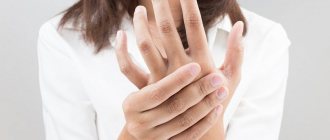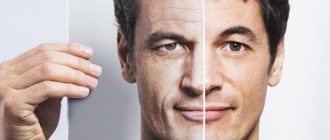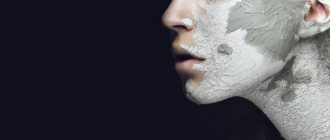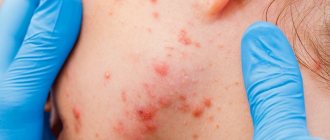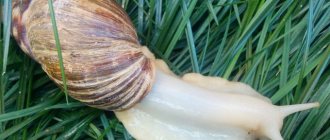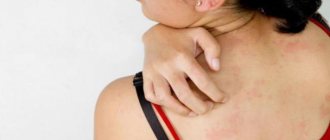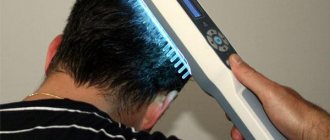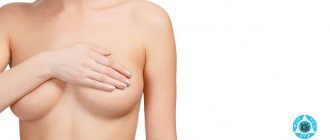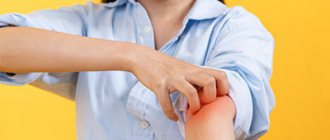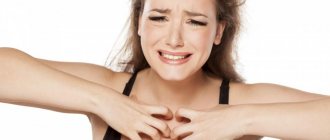Published in the journal: “EFFECTIVE PHARMACOTHERAPY”; No. 45; 2015; pp. 14-18.
THEM. Korsunskaya1, E.V. Dvoryankova1, K.T. Plieva1, O.O. Melnichenko1, 2, S.V. Panyukova1, 2
1 Center for Theoretical Problems of Physicochemical Pharmacology
2 Moscow Scientific and Practical Center of Dermatovenereology and Cosmetology
The article discusses the pathogenesis of skin itching, possible psycho-emotional problems and somatic triggers of itching. The advantages of second-generation antihistamines, in particular cetirizine, are described: in addition to blocking H1-histamine receptors, the drug inhibits the migration of eosinophils in the area of inflammation and suppresses the skin response to platelet-activating factor. The results of our own studies showing the effectiveness of cetirizine in dermatological diseases are presented. Namely: maximum reduction in itching intensity within 3 hours after use during the first five days of therapy.
The skin makes up about 15% of the total human body weight and is the largest organ. Its most important function is protective.
The condition of the skin has a significant impact on a person’s self-esteem and the formation of interpersonal relationships. Itching is an unpleasant subjective sensation that causes the desire to scratch. This symptom in the vast majority of cases causes discomfort, psycho-emotional stress and exhaustion. In addition, scratching damages the integrity of the skin. It should be noted that, despite the high prevalence of the symptom, it has not been sufficiently studied due to the difficulties of its adequate assessment and the lack of models for research.
Pathophysiology
Signals for pain and itching caused by skin causes are transmitted along the same pathways, but the afferent C-fibers differ functionally: one part of the nerve fibers is stimulated by histamine, the other by other substances that cause itching (for example, serotonin). There is evidence of similarities between neuropathic pain, itch and cough. Their common property is peripheral and central sensitization of the afferent nervous system. This explains the effectiveness of antiepileptic drugs and antidepressants for such a variety of conditions, as well as the ineffectiveness or low effectiveness of H1 blockers for some types of itch.
Mechanisms and mediators involved in the formation of the sensation of itching:
- amines (histamine, serotonin, acetylcholine);
- proteases and kinins (tryptase, chymase, kallikrein, bradykini, etc.);
- neuropeptides (substance P, neurotensin, etc.);
- cytokines (prostaglandin E reduces the threshold for susceptibility to itching);
- opioid receptors (metenkephalin, leuenkephalin, β-endorphin), naloxone reduces itching, opiates relieve pain but increase itching.
Mechanisms of development and relief of itching
Hypotheses about the mechanisms of development of itching have been formulated based on studies of the pathophysiology of pain, since pain and itching share common molecular and neurophysiological mechanisms.
The sensation of both itching and pain results from the activation of a network of free nerve endings in the dermal-epidermal zone. The triggering mechanism is the influence of internal or external thermal, mechanical, chemical stimuli or electrical stimulation. Cutaneous nerve irritation can be mediated by several biological agents, including histamine, vasoactive peptides, enkephalins, substance P, and prostaglandins.
It is believed that other, non-anatomical factors, such as psycho-emotional stress, individual subjective perception, the presence and intensity of other sensations and/or distractions, have a significant impact on the degree of sensitivity of itching in different areas of the skin.
The nerve impulse that causes the sensation of itching, which arose under the influence of any of the listed factors, is transmitted through the same neural connection as pain impulses: from peripheral nerve endings to the dorsal horns of the spinal cord, through the anterior commissure, along the spinothalamic tract to the contralateral laminar nucleus of the thalamus. It is hypothesized that the thalamocortical tertiary neuron tract acts as a “relay” for impulse transmission through the integration of the thalamic reticular activating system in several brain regions. In response, there is a desire to scratch the skin, which is formed in the corticothalamic center and is realized in the form of a spinal reflex. After scratching, skin itching occurs again after 15-25 minutes. However, in some cases, especially in patients with chronic dermatoses, the itching sensation after scratching does not stop, which leads to excoriation.
Despite the fact that many etiological and pathogenetic factors contributing to the occurrence of itching are currently known, their study continues and new mechanisms of its development are being discovered.
The mechanism by which itching is relieved by scratching has not been reliably established. It is possible that during scratching, sensory impulses are generated that interrupt the neural arc responsible for the occurrence of sensation.
In addition to scratching, vibration, injections into the itchy area, exposure to heat, cold, and ultraviolet radiation help reduce itching [3].
Pharmacotherapy of hay fever consists of the use of pharmacological agents aimed at eliminating the main symptoms of rhinitis, conjunctivitis, and bronchial asthma. In pharmacotherapy of AR, in turn, the following groups of drugs are used: antihistamines (inverse agonists of H1 receptors), glucocorticosteroids, mast cell membrane stabilizers (cromones), vasoconstrictors (decongestants), less often - anticholinergics, antileukotriene drugs, monoclonal anti-IgE antibodies (Table 2).
Classification
By prevalence
Localized:
- non-specific:
dry skin, parasitic diseases, skin diseases (eczema, bullous pemphigoid, etc.), fungal skin lesions, allergic skin manifestations, insect bites, contact dermatitis;
- specific for oncological diseases:
melanomatosis (for cancer of the anus and vulva), glioblastoma, metastatic skin lesions, paraneoplastic syndrome.
Generalized:
- non-specific:
primary skin diseases, endocrine diseases (hypothyroidism, thyrotoxicosis, diabetes mellitus), carcinoid syndrome, diseases accompanied by cholestasis, blood diseases (for example, Vaquez disease), neurological diseases, senile pruritus, psychogenic pruritus, pruritus caused by infectious diseases, iatrogenic pruritus ( side effects of drugs);
- specific for oncological diseases:
chronic lymphocytic leukemia, Hodgkin's disease, lymphomas, mycosis fungoides (a type of T-cell lymphoma), multiple myeloma, paraneoplastic syndrome.
By genesis
Central:
• neuropathic: brain abscess, brain injury, brain tumor, multiple sclerosis;
• neurogenic: cholestasis, opioids, paraneoplastic process;
• psychogenic: psychosomatic disorder manifested by itching.
Peripheral:
• cutaneous, “pruritoceptive”: cutaneous mastocytosis, medications (± rash), infestations (scabies, lice, fleas, mites), primary skin diseases, plant burns, urticaria;
• neuropathic: postherpetic neuralgia.
Mixed: central and peripheral – uremia.
Folk remedies
There are many traditional medicines known that help alleviate the manifestations of painful itching caused by insect bites, allergies, and fungal diseases. What folk remedies for itching can be used at home:
- An oatmeal compress will help with itching. Regular oatmeal can relieve itching, reduce inflammation, and swelling. The flakes need to be brewed, allowed to brew, cool, then applied in a thick layer to the sore spot, covering the top with gauze. Keep this compress for 20 minutes.
- Chamomile decoction. A baby cream with chamomile or glycerin, or glycerin in its pure form, may be suitable.
- Oil: menthol, peppermint and tea tree. Well suited for intimate areas.
- If your skin is constantly itching, you can make a compress of chickweed leaves or take a bath with the leaves of this plant.
- A decoction of the string. Used to wash the genitals and rinse other parts of the body.
- Aloe is a recognized remedy for itching for both adults and children. You can wipe the sore spots with a cut leaf, make lotions at night: apply half the leaf with the wet side to the body, wrap it with a bandage. You can use natural aloe juice, which is sold at the pharmacy, if you do not have this plant on hand.
- Apple cider vinegar can help treat small areas of scabies. To do this, wipe the itching area with a cotton swab dipped in vinegar.
- An infusion of nettle leaves will help relieve itching from a nettle burn. It needs to be cooled and used to wipe itchy areas after a shower.
- Propolis in the form of an ointment or tincture helps to relieve itching. It is necessary to lubricate the sore spots with a cooled product. It has antibacterial properties and at the same time softens the skin well.
✓ Article checked by doctor
Itching in patients can occur for various reasons, which can only be determined by the attending physician after an in-person examination and testing. Since this symptom can be associated with very dangerous diseases, it is important to immediately consult a specialist if there is systematic itching. Folk remedies and traditional medicines can be used to eliminate the disease.
How to get rid of itchy body skin
Diagnostics
Anamnesis
- Localization : focal or generalized.
- Onset : acute onset is the least characteristic of systemic diseases.
- Duration.
- Nature/character : severe, constant itching, worsening in the evening - scabies;
- “burning” itching – perpetiform dermatitis;
- “tingling” – polycythemia.
Physical examination
- Careful examination of the skin: primary lesions;
- excoriation of the skin in various areas (pediculosis, scabies);
- inflammatory papules on the legs with a small vesicle in the center (flea bites);
- “butterfly” sign in the upper central part of the back (hepatobiliary pathology);
- uremic chills.
Laboratory research
Complete blood count with leukoformula, urea, creatinine, liver tests (markers of cholestasis - alkaline phosphatase, gamma-glutamyl transpeptidase (GGT), determination of bilirubin), thyroxine (T-4) and thyroid-stimulating hormone (TSH), blood glucose.
Rubbing for itchy skin on the body
Vinegar against itching
To eliminate pathology, you should take apple cider vinegar at a 6% concentration. Soak a cotton swab in it and wipe the affected areas. If necessary, you can make a vinegar compress. To do this, take clean gauze, which is thoroughly soaked in the solution and squeezed out. The cloth should be applied to the itchy area for 5-7 minutes. You can repeat these procedures up to two times a day.
Cabbage and agave
For every 100 ml of freshly squeezed cabbage juice, take 10 ml of aloe juice. Typically, the best effect is produced by a plant that is more than three years old. By combining vegetable and plant juice, they should treat all itchy areas of the skin. The procedure can be performed an unlimited number of times until the itching is completely eliminated.
Dill seeds for itchy skin
Baking soda
A universal remedy that can relieve itching of any nature. To prepare a medicinal solution, take 200 ml of warm boiled water and add two teaspoons of baking soda to it. The components should be thoroughly mixed and applied to the affected areas using a cotton swab. You can use soda water up to six times a day until itchy skin is completely eliminated.
Currant, cherry and birch
To prepare the medicine, you should take five freshly picked leaves from the trees. They are poured with two liters of boiling water and left for two hours. After this, 15 ml of salicylic acid should be added to the resulting solution. You can wipe the itchy skin with the infusion up to six times a day until the pathology is completely eliminated.
Attention! Vinegar wipes should be carried out with great care to prevent intoxication of the body. Such procedures should be used locally, since when treating the entire body there is a high risk of poisoning.
Video - Itchy skin. Causes
Patient management
General events
- If your skin is dry, use soap substitutes with a moisturizing effect instead of soap, and apply moisturizing cream to your skin 2-3 times a day.
- Review the list of medications you are taking: if a possible cause of itching is a medication, it needs to be changed.
- For atopic/contact dermatitis: topical corticosteroids once a day for 2-3 days if there is inflammation but no infection.
- For scabies: topical permethrin or malathion.
- For cholestatic itching due to obstruction of the common bile duct: duct stenting – if possible.
Nonspecific treatment
It is carried out taking into account the condition of the skin - different approaches to local treatment on intact and macerated skin.
Antipruritic agents for topical use : 0.5−2% cream with levomenthol (menthol) is effective on intact skin if the itching is localized or more intense in a certain area.
Sedating antihistamines can be prescribed 1 hour before bedtime; if the effect does not persist for a day, two-time use is possible:
- Hydroxyzine/Atarax, Vistaril 25 mg orally at night;
- promethazine/Pipolfen 25 mg orally at night;
- diphenhydramine/Diphenhydramine 50 mg orally 1–2 times a day;
- Dimetindene/Fenistil 1 mg orally daily plus Fenistil gel (0.1% dimethindene) topically 3 times a day will help in most difficult cases.
Some non-sedating antihistamines may have an antipruritic effect (eg, loratadine/Claritin, cetirizine/Zodac, Zyrtec).
Antihistamines for external use (for example, Fenistil cream) on intact skin are used for no longer than a few days in cases where itching is caused by the release of histamine (for example, acute drug rash).
TCAs with antihistamine properties : doxepin/Doxepin in a dose of 10-75 mg orally at night. Antidepressants will help in cases where anxiety or depression occurs.
Specific treatment
Table 1 and Appendix 1 present the principles and regimens of drug therapy for itching of various etiologies.
Cetirizine
Cetirizine inhibits the histamine-mediated early phase of the allergic reaction, prevents various physiological and pathophysiological effects of histamine, such as dilation and increased capillary permeability (development of edema, urticaria, redness), stimulation of sensory nerve endings (itching, pain) and contraction of smooth muscles of the respiratory and gastrointestinal tract. intestinal tract.
In the late stage of an allergic reaction, cetirizine not only inhibits the release of histamine, but also the migration of eosinophils and other cells, thereby attenuating the late allergic reaction. Reduces the expression of adhesion molecules, such as intercellular adhesion molecule-1 (ICAM-1) and vascular cellular adhesion molecule-1 (VCAM-1), which are markers allergic inflammation.
In addition, unlike other drugs used for skin manifestations of allergies, cetirizine not only blocks H1-histamine receptors, but also suppresses the skin response to platelet-activating factor [6, 7]. This is confirmed by the results of numerous clinical comparative studies: the ability to accumulate in the skin allows the drug to relieve itching and hyperemia more effectively than drugs such as ebastine, epinastine, terfenadine, fexofenadine and loratadine [8-10].
Cetirizine has a low volume of distribution compared to other antihistamines - 0.5 l/kg. This provides higher concentrations of the substance in the extracellular space, where H1-histamine receptors are located. This ensures their full employment and the highest antihistamine effect [11]. Another feature of the drug is its high ability to penetrate the skin. 24 hours after taking a single dose of cetirizine, the concentration in the skin is equal to or even slightly higher than the concentration in the blood. The advantage of cetirizine is its steroid-sparing effect: with the simultaneous administration of cetirizine and inhaled glucocorticosteroids in patients with bronchial asthma, the dose of the latter can be reduced or not increased, despite contact with the allergen.
Among cetirizines, Cetrin occupies a special place. In the study by E.E. Nekrasova et al. in patients with chronic urticaria, Cetrin showed the highest effectiveness among other generic cetirizine and the best results in terms of pharmacoeconomics [12].
Useful tips
Systemic treatment is often not necessary if the skin condition improves.
If your skin becomes dry, stop using soap; bathing in warm rather than hot water, lubricating the skin after bathing and at night, applying a damp cloth for 15–20 minutes, then applying cream or ointment.
For damp skin - protective cream (zinc paste), drying dressings with Burov's liquid (aluminum acetate 8%, diluted 1:10–1:20).
Local anti-itch remedies
Zinc oxide has anti-inflammatory, antiseptic and antipruritic effects, and is used in concentrations of 10–50% in creams, liniments, lotions, ointments and pastes that are effective in the treatment of localized forms of itching.
Menthol, when applied to the skin and mucous membranes, dilates blood vessels, causing a feeling of coldness and then numbness, significantly reducing itching. It is used in powders, ointments, and lotions in concentrations of 1–10%.
Camphor , when applied to the skin, produces a warm sensation followed by mild anesthesia, which reduces itching. It is used in the form of liniments, lotions and ointments in concentrations of 2–20%.
Important
It should be remembered that products with menthol and camphor cannot be used simultaneously on one area of the skin.
Calamine , a lotion containing zinc carbonate (calamine), zinc oxide and a small amount of phenol, is widely used in the treatment of itching and atopic dermatitis.
How does scabies spread?
Direct infection with scabies
Scabies is usually transmitted through direct skin-to-skin contact with a person with scabies. Scabies is most quickly transmitted between sexual partners and people living together. Scabies is not usually spread by a quick handshake or hug. The scabies mite can live on a person for 1 to 2 months and can be transmitted to another person at any time during this period.
Indirect contamination
Without humans, scabies mites survive up to 2-3 days. This means that scabies can be transmitted indirectly, through sharing clothing, towels or bedding with a person with scabies. More information on sterilizing these items can be found in the section “How to get rid of scabies mites in the house.” Indirect infection usually occurs with crustose scabies. Scabies is not usually transmitted through swimming pool water.
Scabies that appears in humans is not transmitted through animals. Pets can harbor other types of scabies mites that do not live on humans.
Visit a doctor if signs of scabies appear
If after the appearance of signs of scabies you make an appointment with a doctor, then warn the staff about this. They will take you straight to the examination room. Avoid staying in waiting rooms, cafeterias, and other public places. Family members or friends accompanying you to the hospital should wash their hands with soap or an alcohol-based hand rub.
to come back to the beginning
Care Tips
- Prevention of scratching: short-filed nails, lightly rubbing itchy areas.
- After washing, dry your skin carefully using wet movements, use a soft towel or a hair dryer on a cold setting.
- Avoid long hot baths. Try a bath with sodium bicarbonate (baking soda) or medicated oils.
- Use loose clothing and loose bedding/blankets.
- Avoid overheating and sweating, especially during night sleep.
- Increase the humidity in the bedroom so that your skin loses less moisture.
- Wear cotton gloves at night to prevent scratching.
- Avoid damaging the skin with alcohol-containing rubbing, woolen clothing, and excessive hygiene procedures.
- Cleanse your skin gently using moisturizers.
- Use cooling, soft compresses.
- You can use an anesthetic mixture: aftershave cream with menthol 50 ml, Diphenhydramine 1% 3–5 ml, Lidocaine 2% 1–2 ml, Novocaine 0.5% 5–10 ml. Mix and serve chilled.
- Use relaxation and positive visualization techniques.
How to relieve itching at home
There are many folk and medical methods that will tell you how to remove itching quickly and without leaving a trace. You will always find some of them in your kitchen, while others are worth having in your medicine cabinet just in case. You need to figure out for which cases certain remedies are suitable, and not be overzealous with self-medication if the condition worsens. Below are the main ways to help soothe the burning sensation in different parts of the body.
A solution of soda for itching has been used for a long time: this natural remedy best helps with insect bites and allergic rashes. You can use it as a bath filler (1 glass per bath with cool or warm water), as an additive to hand or foot baths. Soda is suitable as a compress: you need to apply a soda solution to a cold cloth or towel and apply it to problem areas for 30 minutes.
Medicinal herbs
Herbs for itching are used in the form of decoctions for rinsing, lotions, or oral administration: they are good at helping to soothe irritation and relieve inflammation from itchy areas. Fresh aloe stems are effective - cut them lengthwise and lubricate the sore spot with gel-like juice. A decoction of peppermint tones and softens the skin, and a tincture of calendula, chamomile and sage will help relieve burning and cool the skin.
Work on this problem at the Marina Ryabus clinic
A person who comes to a trichological appointment with complaints of itching and dry scalp will be comprehensively examined to develop the most effective treatment strategy. We will give you a phototrichogram - the method allows you to specifically study the condition of the hair follicles, hair, and scalp. The doctor will take a medical history, asking you questions about your eating habits, regularity of stress in your life, home care, etc. To form a complete picture, you will be sent for tests. We cooperate with the best laboratories in terms of diagnostic expertise. Tests can be taken on the day of your visit to the clinic. Please note that some tests require fasting blood donation. Based on the results of laboratory diagnostics, you will be offered an individual regimen for taking dietary supplements - vitamins, amino acids, minerals. The doctor will also give nutritional recommendations and select a line of care products for you (our partner is the professional cosmeceutical hair care brand Eliokap).
And, of course, procedures will be offered to you according to your indications. This could be mesotherapy with a cocktail rich in beneficial substances. It restores the healthy activity of the sebaceous glands, helps soothe the skin, and eliminates the problem of peeling and hair loss. To relieve inflammation around the hair follicles, improve hair growth and prevent alopecia, laser scalp treatment procedures are prescribed. At the Marina Ryabus clinic, these procedures are performed on the multifunctional Fotona SP Dynamis platform.
By following an individual treatment plan, you will definitely begin to notice how the quality of your skin and hair has improved. And, of course, the itching problem will be solved. If the doctors at the Marina Ryabus Clinic need to involve specialized specialists from other fields of medicine in the treatment (for example, if the itching is caused by allergies or nervous disorders), we will give you the necessary recommendations.
Marina Ryabus Clinic is a center for scientific cosmetology and anti-aging medicine. We will help you maintain beauty, health, activity and interest in life for as long as possible!
To make an appointment, call: +7 (499) 588-81-47;. You can also contact the clinic administrators on WhatsApp, Telegram, Viber by phone: +7 (925) 397-71-30. To receive a call back from the clinic, fill out the feedback form on the website.
